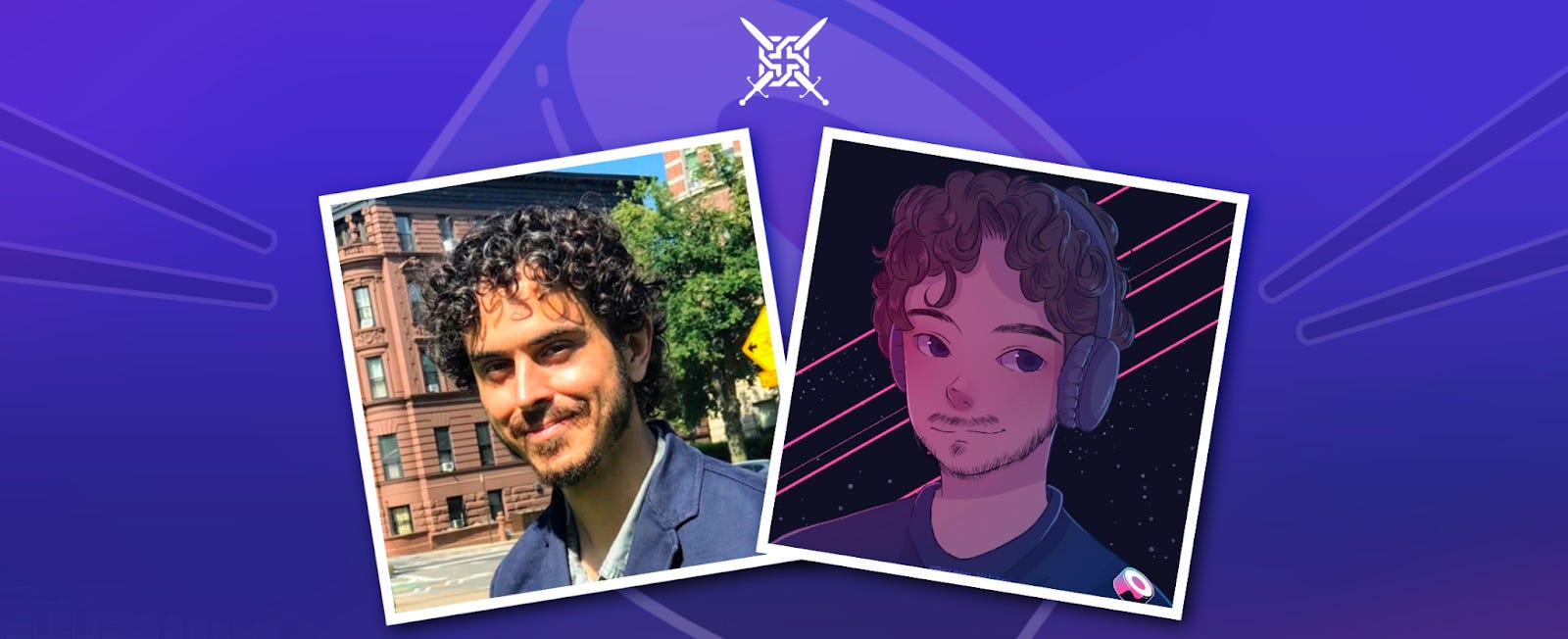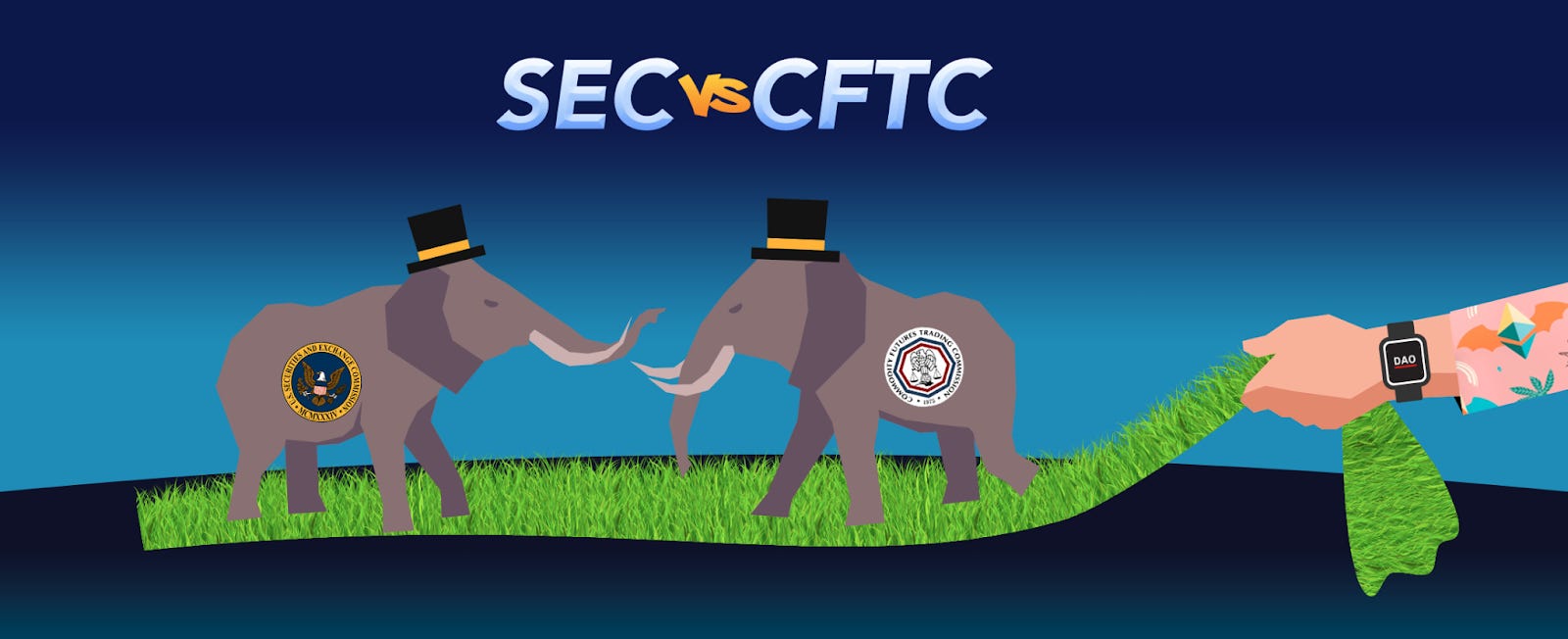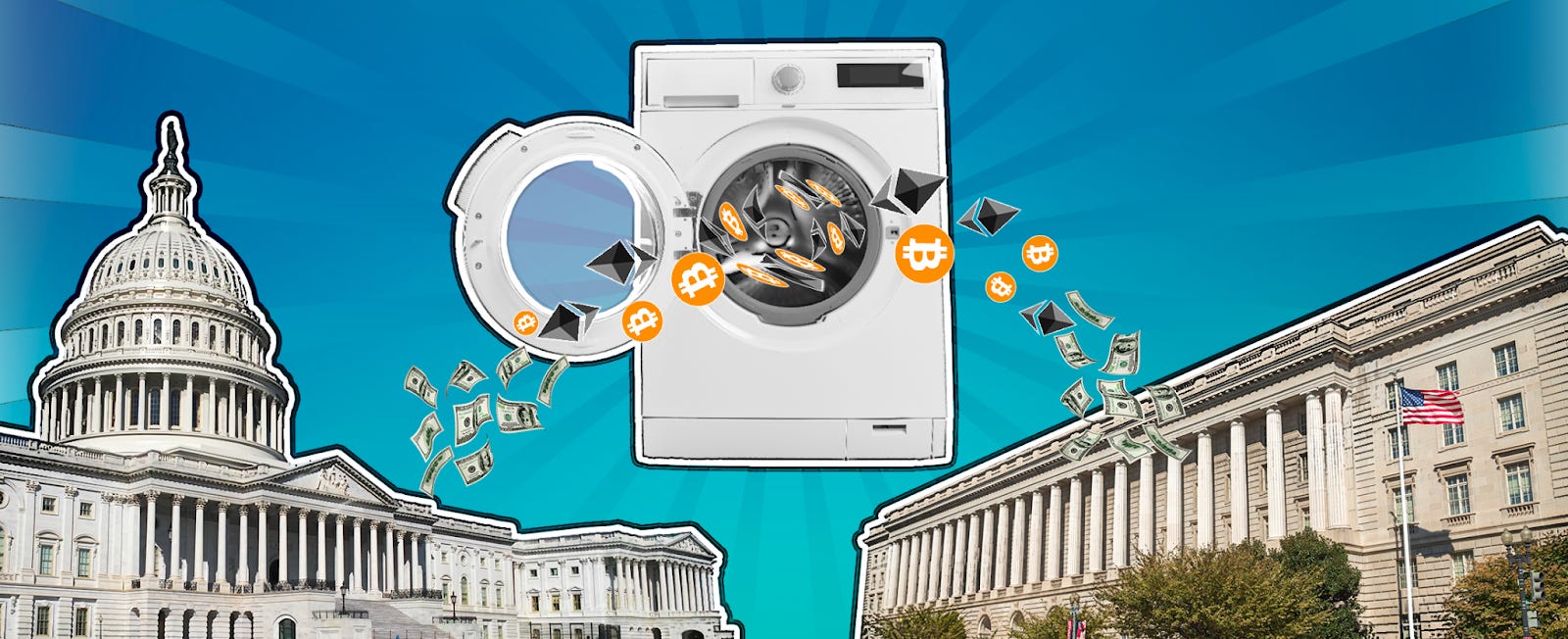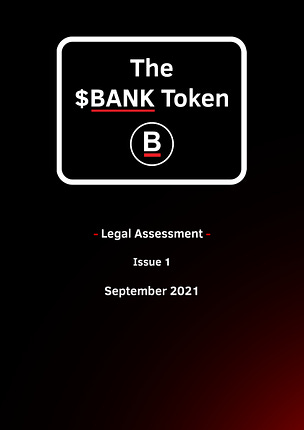How to Become a Crypto-Lawyer | Decentralized Law #1
Dear Bankless Nation, Whether cryptocurrencies or legal proceedings, blockchain-based technologies are gaining traction and changing the ways in which we interact with familiar institutions. Borders become meaningless. Institutions become flatter. From the outside, the world looks the same, but to those of us on the inside, we know the mechanics of human relations are changing. New people enter the cryptoverse with innovative ideas that give rise to new projects. The blockchain ecosystem is an ecosystem of opportunities for those talented individuals curious enough to explore the digital frontier. That the cryptoverse is full of opportunities for those who seek them is particularly true for lawyers. The rapid growth and regulatory uncertainty within crypto provides adventurous attorneys with the chance to work at the forefront of regulatory and social change, while gaining invaluable experience helping blockchain-related projects and DAOs navigate this new legal landscape.  Blockchain-savvy lawyers are well-placed to promote best practices and to ensure that these ground-breaking and disruptive on-chain projects operate within existing legal frameworks. Lawyers play an important role in influencing the design of new legislation, particularly through educative efforts to avoid the introduction of detrimental legislation by uninformed representatives. To be an effective crypto-lawyer, you need to understand not only the regulatory rules and political environment, but also the fundamentals of blockchain technology and the expectations of people working within the industry. In this issue of Decentralized Law, we discuss essential aspects of being a crypto-lawyer with Ross Campbell, the code-literate founder of LexDAO and a crypto-lawyer working with many high-profile protocols. We will also highlight legal entity solutions for DAOs, provide an analysis of hacking to explore the interplay between computer code and the law, survey the new FATF crypto guidelines, and review the brewing turf war between the SEC and CFTC in our new opinion section. The monthly taxation corner will be devoted to wash and constructive asset sales and in DAO Legal Tools we examine the new Aragon dispute resolution platform. Welcome to Decentralized Law. Although this newsletter may help to familiarize readers with the legal implications arising from blockchain technology, the contents of Decentralized Law are not legal advice. This newsletter is intended only as general information. Writers’ opinions are their own; therefore, nothing in this newsletter constitutes or should be considered legal advice. For that, contact a legal expert in your jurisdiction. Authors: BanklessDAO Legal Guild (eaglelex, lion, hirokennelly.eth, taxpanda, Tayy, Decentralawyer, Larry Florio, themuss, Terumask, drllau, Trewkat) This is the official legal newsletter of the BanklessDAO. You are subscribed to this newsletter because you were a Premium Member of the Bankless Newsletter as of May 1, 2021. To unsubscribe, edit your settings here. 🎙 InterviewUnderstanding Crypto-Law with Ross Campbell
I started my journey into crypto as a typical corporate associate, doing “big law” to pay for debts, but to also get an injection of practical experience. At the time, there was a surge of high-profile cybersecurity and ransomware hacks, such as the Yahoo! data breach, and this introduced me to Bitcoin and these grey markets. In order to recover the “crown jewels” of many of these companies, people needed to become pretty sophisticated on how to handle cryptocurrencies to recover their databases. That was just the table stakes. But what was more interesting, was learning how much more secure a distributed ledger, which arguably supported these attacks, was to secure mission-critical data, and this sense of irony pushed me deeper. As luck would have it, I then quickly came across several prototypes for these things called “smart contracts” put together by law firms like Hogan Lovells, to automate distributions of payments for insurance claims, and it became clear that a sturdy, programmable ledger that could move funds predictably across borders would be a killer app in transactional law. I then left my law firm, completely dove into smart contracts, and found myself at Consensys and the OpenLaw project. From there, I began helping with their agreement automation software, which then grew into launching a few smart-contract-based investment funds (such as the LAO and FlamingoDAO) and helping craft some common sense legal solutions, such as streamlining investor accreditation, forming limited liability DAOs, and standardizing fundraising code, such as MolochDAO v2, to support this use case.
No, though it can help to more quickly understand developers and their business. With smart contract programming, and learning languages like solidity, it can also be an edge, as you can more credibly suggest technical solutions that match legal advice, such as adding code-based safeguards or compliance checks for regulated offerings. It always helps, I think, to be able to move very quickly with a client in Web3 to actual results, and if you can code, you can cover a lot of ground, such as helping launch their company with an on-chain representation without needing to involve additional third parties.
I would say first, “don’t be shy!” This field is ripe for new entrants and fresh ideas. Join a DAO, lurk in a discord, write some tweet threads about projects that interest you and might involve some legal research you do in your spare time. All of these things are usually greatly appreciated and people remember those who “build in public” or share their ideas, especially from the legal field, which has a reputation for being more guarded. I would also suggest reading up on DAO forums, and giving feedback to proposals—this can be a pretty quick way to add a lot of value and have a lot of personal impact on this space in the early days.
Research on constitutional, or more normative protections for privacy and property rights feels fundamental here, to help judges understand overarching concerns versus regulatory mandates. But more specifically, I think fundraising using social tokens and NFT collectibles could use more guidance from the legal community, especially where there are expectations of airdrops and additional value distributions. Helping define when a project becomes community-based and providing arguments and examples on how this actually works in practice would also be very useful to Web3.
It will make lawyers more strategic advisers rather than rote document workers, I expect. We can already see how open source legal resources, such as common market agreements that are easy to access, with automated e-signature, empower people to reach agreement far more quickly and easily online, and we can’t underestimate the power of internet research, the school of “Google law” to provide the gist of many law firm consultations. So, lawyers will increasingly be partners and fellow-travelers on the journey of entrepreneurs, because they will still have an excellent sense of blockers and legal risk that can trip up a company’s growth. DAOs and smart contracts will also help align incentives, I imagine, in how clients retain and reward attorneys for providing timely advice, as everybody wants to win together rather than have a back and forth over fees-for-hours.
“Code is law” for me suggests an evolution, rather than replacement, of how we all reach finality in our relationships, that is, how we settle what we promise and ultimately expect from each other. For example, programmable ledgers like Ethereum allow us to print promises and have related execution of promised assets with a great deal of predictability that used to be reserved solely to legal systems that just provide ex post remedies. Law will still affect how people interpret whether code was properly deployed, if negligence claims might be made against developers, and for blockchain validators, the risk of certifying certain transactions. I like to say these are “Layer0” considerations, but what I really mean is that software is being run by people, and people coordinate using law, and this is a base layer. What is different, perhaps, these days, is how we understand record keeping, and execution that plugs into this legal Layer0 will be increasingly code-based, and living on a credibly neutral ledger like a blockchain, to help avoid disputes and accelerate how quickly we can use the traditional legal system. 🏛 Regulation - DAO Global Entities Monthly SeriesLegal Recognition of DAOs: The Wyoming WayAuthor: Lion917
The U.S. state of Wyoming has long prided itself on its progressive commercial laws, being the first state to authorize limited liability companies in 1977. Since 2018, it has pioneered numerous legislative agendas to position itself as the most crypto-friendly state in America. On July 1, 2021, Wyoming’s DAO Supplement bill (Bill) became law. The Bill clarifies the status of Decentralized Autonomous Organizations (DAOs) as applied to traditional for-profit Limited Liability Companies (LLCs). DAOs have grown exponentially as a result of the recent cryptocurrency boom. These organizations are technologically advanced, but unlike traditional companies, they frequently encounter regulatory obstacles. Without a legal identity to bind collective decision-making, DAOs are unable to contract with third-party enterprises. As a result, these new organizations are unable to enter into basic commercial arrangements, cannot engage service providers, and are largely unbankable, which prevents them from interacting with traditional businesses. Additionally, a DAO that lacks legal recognition operates as a general partnership in many jurisdictions, exposing its stakeholders to personal liability, both joint and several, for any pending liabilities or legal actions brought against the DAO. Wyoming’s new Bill extends its existing Limited Liability Company Act to DAOs, thus granting them the legal status of an LLC. An LLC limits the liability of its members by creating a corporate veil. In other words, the entity’s members are not personally liable for the debts or legal responsibilities of the LLC. The Bill also helps minimize double taxation and allows for pass-through deductions, as LLCs are taxed just once on each member’s individual income tax return. LLC members may even be able to deduct 20% of their business revenue as permitted under The Tax Cuts and Jobs Act. Interestingly, a suffix of “DAO LLC” or a combination of the entity indicators is required to be added to the name of the organization. The Bill also provides an avenue for an existing Limited Liability Partnership to be converted into a DAO after proper amendments to its founding documents. From a technical standpoint, the Bill recognizes two forms of DAOs: member-managed and algorithmically-managed. Under the Bill, a member-managed DAO is analogous to a member-managed LLC, as the management of the organization is entrusted to the registered persons or entities. While the term “algorithmically-managed” is ambiguous and the law is too new for informative precedence, it is reasonable to assume that the law contemplates an algorithmic decision-making protocol that exists on a blockchain and aids in DAO governance. An algorithmically-managed DAO may register only if the controlling smart contract system is functioning at the time of filing. Notably, the legislation recognizes smart contracts as the principal governing instrument for DAO members’ rights. With respect to decision making, a member-managed DAO LLC (in Wyoming) is managed by a majority vote of the DAO’s membership interests. A membership interest is calculated by dividing a particular member’s contribution of digital assets to the organization by the total amount of digital assets contributed to the organization at the time of a particular vote. If contribution of digital assets is not a prerequisite to becoming a member, each member will possess one membership interest and is entitled to one vote. This ensures that every DAO member, regardless of whether they contributed digital assets, will have an equal vote on fundamental matters, such as the DAO’s dissolution. With respect to information rights, members do not have the right to inspect or copy records of the DAO. Such rights are limited and are available only to the extent such information is available on an open blockchain. If the Articles of Organization of a DAO do not state whether it is a member-managed DAO or an algorithmically-managed DAO, it can be presumed the DAO is member-managed. Wyoming aims to adopt more than 24 blockchain-friendly laws to make it easier for the technology to flourish in the state. Wyoming has recognized an individual’s property rights to own digital assets, authorized banks to act as custodians for digital assets, and introduced banking services to blockchain businesses. While Wyoming’s favorable approach is commendable, there are other options available for DAOs wishing to shield members’ liability. DAOs could alternatively be based on the Swiss Association (Verein) model, a very attractive model for decentralized initiatives. As with Wyoming’s new Bill, the Swiss Association model follows the principle of “separate legal entity” with minimum filing requirements (if unregistered). In a Swiss Association, the assets and earnings of the Swiss Association are controlled by the member firms, which is analogous to the decentralized model followed by DAOs in Wyoming. Registration of foundations in jurisdictions like the Cayman Islands remains a viable option, but such registration might lead to doubts regarding legitimacy in the eyes of the general public. Wyoming’s legal recognition of DAOs is a positive step towards building blockchain-based organizations, but other U.S. states and U.S. federal laws have not yet caught up. It will be interesting to track the jurisprudential growth and evolution of these laws as regulators and courts navigate these uncharted waters. ⚖ DevelopmentsCan Hacking be Lawful?Author: eaglelex
What makes blockchain technology particularly potent—in the words of Primavera De Filippi and Aaron Wright—“is its ability to facilitate the creation of resilient, tamper resistant, and automated code-based systems that operate globally, providing people with new financial and contractual tools that could replace key societal functions.” Blockchains enable people to build their own systems of rules using smart contracts, which are enforced by the underlying protocol of a blockchain-based network. Due to the possibilities offered by blockchain technology, it has often been said that these systems can create order without relying on the law. It is sometimes said that the code itself is the law. In practice, developers have the capacity to create tools and services that avoid jurisdictional rules and operate transnationally. The creation of a space which is not bound by the laws of nations is advocated by Barlow’s “Declaration of Independence of the Cyberspace.” But it seems that blockchain technology may not permit this utopian dream to materialize smoothly. Many operators in the industry are aware that not all blockchain-based applications comply with existing laws, especially when it comes to highly regulated financial services and anti–money-laundering provisions. Nevertheless, many users of blockchain protocols believe that code and smart contracts, as an expression of private autonomy and contractual freedom, may substitute for traditional contractual arrangements. Not surprisingly, different opinions exist on the matter. Lately, the issue has been scrutinized with respect to a hack that removed 16 million USD from the decentralized finance (DeFi) protocol Indexed Finance. Indexed Finance is based on Ethereum and produces tokens that track market indexes. A hacker claimed the assets backing the value of the Indexed tokens by finding a vulnerability in the protocol’s smart contracts. The attack has been described as a “typical” DeFi exploit: the hacker took advantage of the flash loan mechanism by overloading the protocol with new assets. This lowered the price of the Indexed tokens, which then allowed the attacker to mint new ones at an artificially suppressed price and cash them out. The hack negatively affected many users, as two out of the six assets of the protocol lost most of their value. Laurence Day and Dillon Kellar, two core members of the Indexed Finance team, managed to identify the perpetrator, an 18-year-old university student. Indexed Finance, wanting to avoid doxing and law enforcement, offered the young hacker a way out: restore the stolen funds minus a 10% bounty. Surprisingly, the young hacker did not want to cooperate. He publicly stated via tweets that he had not infringed the law but had executed a clever arbitrage trade through a complex series of transactions. In addition, he asked for legal representation from crypto-lawyers willing to defend him in court. The perpetrator’s position recalls the highly debated “code is law” formulation as expressed in the original DAO hack. From this perspective, if a person executes transactions permitted by the code then his or her behavior may not be considered unlawful. This view was affirmed by the Singaporean Court of Appeal, which effectively noted a “poor bargain was still a bargain.” This position reveals the gap between what is algorithmically permissible and socially or legally acceptable. The facts have ignited a discussion within the crypto-legal community. Indexed Finance has, of course, a different opinion on the legality of the perpetrator’s actions. Jason Gottlieb, a well-known lawyer in the crypto space, responded to one of the perpetrator’s tweets, declaring: “Code is not law. Law is law. And what you did was not a ‘clever trade.’ It was market manipulation. It’s illegal. And people go to prison for it.” Most lawyers in the world would probably agree with Gottlieb, but it is also true that there is an argument that may be used in favor of the perpetrator. This argument invokes one of the main claims of blockchain technology and smart contracts, namely that code is able to eliminate the need for intermediaries by producing predictable outcomes. In addition, the exploitation could be seen as a failure of Indexed Finance’s smart contracts. Apart from what happened to Indexed Finance, within an ecosystem yearning for self-regulation and accountability, it may seem contradictory to seek legal enforcement when things turn out badly. One has to decide: is it possible to embrace and respect the mandates of a legal system or must parties choose to move towards ever greater decentralization to avoid the application of a nation’s laws? Cherry picking among favorable legal rules as the need arises seems an unfair option, while seeking prosecution for market manipulation or other crimes could be seen as a defeat for the DeFi industry. Of course, there is also another view on this issue. One could easily argue that the code used to create the smart contracts does not represent the entire “social agreement” surrounding the use of a given protocol. Making individual gains by destroying the wealth of a community should be seen as unacceptable and a violation of this more holistic social agreement. The Indexed Finance hack shows once more that certain values should always be respected within the industry. Hackings and exploitations portray cryptocurrencies in a bad light and may hinder the growth of the market.  Law enforcement could be seen as a defeat in the short term, but in the long run, it may foster fair behavior among people operating in this space. The code is not law, but it would be amazing—in the name of contractual freedom—to run a system based on code without actually needing to apply the law. FATF Guidance on Virtual Assets and Virtual Asset Service Providers: A Brief OverviewAuthor: Decentralawyer TL;DR It is difficult to understate the grave implications of the Financial Action Task Force (FATF) guidance released in late October 2021. The FATF’s approach is essentially to subject cryptoassets and cryptoasset providers to the same level of scrutiny and regulatory compliance as financial institutions, including “know your customer” regulations. This approach is almost certain to be adopted by several of the world’s largest economies, and presages nothing less than an imminent war on crypto. Buckle up—we are in for a bumpy ride. Background: The FATF The FATF was established in 1989 to be the global advisory watchdog on Anti–Money-Laundering (AML) and Combating the Financing of Terrorism (CFT) matters. The FATF’s reach is long. It has 40 member nations, but some 200 countries have committed to implement FATF standards, and abide by FATF’s mission, by way of their own local rules and oversight/enforcement mechanisms. It exerts strong influence over governments, including legislators, central banks, financial regulators, and departments of justice. The FATF’s role is to set standards for AML/CFT policy and to evaluate countries on their implementation of those goals. Along the way, it occasionally issues guidance. Guidance does not have the binding status of recommendations mirrored by legislation—rather it is meant as commentary to help countries interpret the standards and implement their own national rules and AML regulations. Nevertheless, the recent guidance answers some important questions while, unfortunately, introducing new ones. A Bird’s Eye View It is clear that the FATF is taking an expansive approach which preserves government flexibility and discretion. This approach expands upon definitions of virtual assets (VAs) and virtual asset service providers (VASPs) found in guidance from 2018 and 2019. The guidance confirms, inter alia, that:
The FATF directs governments to address a number of specific AML/CFT concerns, including privacy wallets, obfuscation of identities, ransomware, digital layering schemes, stablecoin governance, frauds, and a rather shrill laundry list of potential criminal activities that may be furthered by VASPs, including child exploitation and human trafficking. Who is a VASP? As noted, the FATF explicitly adopts an expansive definition of VASPs, setting out a rather broad owner/operator test to determine when an organization (or individual) is providing services relating to VAs and is thus considered a VASP. A VASP is an individual or organization that is not covered elsewhere in the FATF regulations, and provides commercial services which enable any of the following:
It is important to note that traditional financial institutions are not considered VASPs because they are addressed elsewhere in the FATF regulations. “Control” over virtual assets is one of the defining elements of being a VASP. Control is defined as the ability to hold, transfer, or spend the virtual asset. Additionally, the FATF is strongly encouraging governments to take a “substance over form” approach, looking through ostensibly decentralized protocols to ascertain whether certain individuals or entities do, in fact, exercise control over the VA. This approach seems to be motivated by the concern that protocol developers are using decentralization to conceal their influence. Multi-sig safes, for example, are likely insufficiently decentralized to escape classification as a VASP. The guidance does note that where a protocol is sufficiently decentralized, a VASP may not exist. However, it is not clear what level of decentralization is required to allow developers to escape VASP classification. Mere automation of VA-related services, for example, is not sufficient. This raises the question: What does a truly VASP-less virtual asset protocol look like? The guidance provides very little clarity on this crucial question. The Guidance and NFTs The guidance notes that NFTs are “generally” not considered to be VAs—but that sometimes they can be. As noted above, the FATF’s functional approach requires regulators to look at substance over form. Observers of the NFT ecosystem will note that many NFT projects may be classified as artwork or collectibles while simultaneously enabling various forms of decentralized finance (DeFi) functionality, such as staking and yield farming. Such DeFi functions are likely indicia that the NFTs are virtual assets, with the result being that many NFT project teams are likely VASPs. If that analysis holds true, the compliance obligation for NFT projects would be immense. Project developers would likely be required to conduct AML/CFT identification and reporting of NFT purchasers. Shortly after the guidance was released, the U.S. Office of Foreign Assets Control imposed sanctions on a number of accounts holding cryptoassets, including NFTs, on charges related to money laundering and election interference. It would seem NFTs are well within the regulatory crosshairs. The Guidance and Stablecoins The guidance indicates that stablecoins are likely to be virtual assets. Furthermore, it suggests that stablecoin operators are more likely to be VASPs, because the very act of stabilizing the coin implies the presence of an element of control. This section should, perhaps, be read in combination with the recent U.S. government report on stablecoins, which seems to suggest that the U.S. will only permit registered financial institutions (read: TradFi) to issue stablecoins. The FATF guidance provides the rationale for stamping out non-registered stablecoin issuers, while the stablecoin report seems to place authority over stablecoins directly in the hands of the traditional financial industry. While this guidance is certainly related to the myriad legal and ethical questions surrounding the activities of Bitfinex (parent company of the Tether stablecoin), more responsible stablecoin issuers will be caught in this crossfire. The Guidance and CBDCs The guidance explicitly notes that it does not address central bank digital currencies (CBDCs) because they are fiat currencies issued by governments, and thus are not VAs. This deference to government-issued currencies should come as no surprise to seasoned policy observers, as cryptocurrencies represent a clear threat to sovereign monetary authority. Governments and central banks are accustomed to controlling their own monetary policy and are unlikely to remain sanguine about the possibility of cryptocurrencies eroding that control. There are, of course, real AML/CFT threats from cryptocurrencies, but it is hard to view the exclusion of CBDCs from the VA framework as anything but a pretext for clearing the way for governments to issue their own stablecoins. Indeed, the fact that the guidance expressly leaves out CBDCs suggests that government-issued digital currencies may be on the near horizon. It remains to be seen how such CBDCs will function in comparison to cryptocurrencies, and whether they will play well with existing blockchains. What Next? With the FATF approach on VAs/VASPs finalized, we must now wait for other countries to implement new measures to tackle VASP compliance. There will doubtless be regional variations in regulatory approaches, and it remains to be seen what (and where) the “floor,” or minimum compliance standard, will be. The world’s largest economy, the United States, is likely to take a strict approach. Game theory would suggest that other nations may attempt to enact more rational frameworks to encourage innovation, attracting VASPs fleeing stringent U.S. regulations. But one thing is certain: we would all do well to continue to monitor this space for developments affecting not just ourselves, but the ecosystem as a whole. 👩🏫 OpinionCrypto Battle Round 1: SEC vs. CFTCAuthor: hirokennelly.eth
There’s a fight brewing, a bureaucratic fight for the right to regulate the cryptoverse in the United States. In one corner, the Securities and Exchange Commission (SEC), the nearly 100-year-old agency tasked with oversight of securities issuance and trading. In the other corner, the Commodity Futures Trading Commission (CFTC), the 50-year-old agency that regulates derivatives markets, including futures, swaps, and certain kinds of options. The SEC fulfills two main purposes. One purpose is to provide a level of transparency to the public regarding the business operations of companies offering securities, the specifics of such securities, and the risks to investors who purchase them. In addition, the SEC’s mandate ensures that it has oversight over those who trade securities, including brokers, dealers, and exchanges. Gary Gensler, the Chairman of the SEC (and a former professor at MIT who taught a course on blockchain technology) believes many crypto assets are securities and therefore the SEC is best suited to regulate U.S. crypto activities. He argues that as the SEC has authority under its current enforcement mandate to oversee stablecoins, it is natural for the SEC to regulate decentralized finance platforms. On the other hand, the CFTC oversees the derivatives market, arguably the largest financial market in the world: swaps alone are notionally valued at 400 trillion USD. A derivative is essentially a contract between two parties that relates to a security but is not itself a security. The CFTC encourages competitiveness and efficiency and ensures the integrity of derivatives. Key aspects of the agency’s mandate are to protect investors from market manipulation, abusive trading practices, and fraud, and to regulate the settlement of transactions (also known as clearing). Rostin Behnam, the Acting Chairman of the CFTC, recently testified before the Senate Agriculture Committee (yes, you read that correctly!) that the CFTC is the proper governmental agency to regulate crypto markets. The CFTC believes the majority of crypto assets are derivatives of underlying “commodities,” such as bitcoin, and it has a history of enforcement actions against crypto exchanges and assets, most notably Kraken and Tether. With the meteoric growth of the cryptoverse, these two federal agencies are jockeying for position to regulate digital assets, particularly blockchain-powered technologies. As stated, the SEC views most cryptocurrencies and related assets as securities, while the CFTC tends to view the majority of crypto assets as derivatives. It’s no real surprise that these bureaucratic agencies are each using self-justifying definitions to expand their own mandate, a problem made worse by the lack of leadership from Congress. Unlike some other nation’s governments, Congress refuses to consider sensible legislation to regulate blockchain technologies. The conflict between the SEC and CFTC was recently laid bare in In re Tether Holdings Limited et al. In that proceeding, the CFTC brought an enforcement action against entities related to Tether’s stablecoin, USDT, on the grounds that Tether violated a number of CFTC provisions relating to fraud and material misrepresentation. The basis for the CFTC’s action was Tether’s representations that USDT was backed by fiat currency in a one-to-one ratio. Tether later admitted that USDT was not, in fact, backed by such a ratio, but was instead backed by a menagerie of regular and more exotic assets. The October 2021 Order entered in Tether Holdings mandated that Tether and its related entities pay a 41 million USD fine. Notably, this settlement was one of the first formal actions taken by U.S. regulators against stablecoins, and arguably the most visible and successful. Despite this successful enforcement action by the CFTC, it appears that the SEC will also continue to subject stablecoins to its regulatory oversight. Under the President’s Working Group Report on Stablecoins (Report) released on November 1, 2021, a mere few weeks after the CFTC settlement with Tether, the SEC reasserted its claimed authority over the regulation of stablecoins, particularly when these stablecoins are used in investment transactions. Unfortunately, the Report makes it clear that the U.S is no closer to clarity on the scope of the mandates given to these two regulatory bodies with respect to the cryptoverse in general, and stablecoins in particular. And if we need to further increase the regulatory murkiness, that same Report called on Congress to pass legislation that would view stablecoin issuers through the lens of regulated banks. A fair reading of both agency’s mandates would suggest that neither the SEC nor the CFTC is the proper regulatory body for U.S. crypto markets. Although there is a history of cooperation between these regulatory bodies, such cooperation could serve to heighten bureaucratic hurdles and stymie the rapid innovation occurring in the cryptoverse. For those of us who spend our days in the cryptoverse, we know that one month passes for three years and that there is no time to waste on bureaucratic infighting. If the U.S. wishes to lead the world in cryptoassets and prevent an exodus of money and talent, a creative and flexible regulatory approach is critical. But there is no indication of any such creativity from Congress, and so a battle for turf seems inevitable. Lost in all of this are the builders, creators, and investor-pioneers at the frontier of the blockchain revolution. An African proverb is useful here: when the elephants fight, the grass gets trampled. The warning for market participants is clear: these innovative creators and consumers are the figurative grass on which these mandate-bloated elephants fight. Yet there is no need to abandon hope for the future of crypto in the U.S. Many believe that this time will be different, that the proverb will not materially manifest, and that the grass will remain untrampled. Instead, these historical institutions will discover that they were fighting on a turf rug all along, a rug that gets pulled by the strongest hand of all, the will of the people. See the Call to Action at the end of this issue for details on how you can contact your representatives to have your say on Congress’ approach to regulation of the U.S. crypto market. For the sake of our industry, please heed this call. 👮♂️ TaxationThe U.S. Reconciliation Bill Would Change “Wash Sale” and “Constructive Sale” Tax Rules to Apply to Crypto...What?Author: taxpanda
This month U.S. President Joe Biden signed what is essentially the spending half of the Bipartisan Infrastructure Bill, and attention will now turn to the reconciliation bill that will be considered (and likely amended) in the Senate. There’s no telling how long the reconciliation process will take, but there are a number of reasons why U.S. lawmakers will want to move the process along as quickly as possible and get the bill signed into law before the end of the year. As it stands, the draft bill (at roughly 2,000 pages) is full of changes to U.S. tax law that are meant to raise revenue to support the 1.2 trillion USD infrastructure bill. Two of these changes have been a hot topic in the crypto community: application of the “wash sale” and “constructive sale” rules to digital assets. Understanding the impact of these new rules could prove to be very helpful to both crypto-investors and tax planners. The wash sale rules generally prohibit investors from claiming a deduction when they sell an asset at a loss if they buy a “substantially identical asset” within 30 days before or after the date of the loss sale. For example, assume that Ethel bought 100 “xCoin” on June 1, 2021 for $1,000 and then sold all of her xCoin on November 1, 2021 for $200. Ethel has created an $800 capital loss with regard to xCoin, which under the current U.S. tax rules, permits her to offset some of her other 2021 capital gain. However, Ethel is still bullish on xCoin and repurchases 100 xCoin on November 10, 2021 for $250. Under the new law, Ethel would be prohibited from using the $800 capital loss to offset any capital gain because she bought xCoin less than 30 days after her first xCoin sale. As a result, Ethel would be required to add the $800 capital loss to her tax basis in the newly bought xCoin, which could be useful in the event that xCoin does increase significantly in value (as her basis would shield gain on a future sale of the xCoin). However, the $800 loss does little to help Ethel with her other 2021 capital gain as a result of the proposed wash sale rules. The constructive sale rules apply when an offsetting long or short position is taken against an asset that is currently held in order to reduce the risk of losing money on the investment. The effect of the constructive sale rule is that the taxpayer would be required to pay tax with respect to the capital gain on the long position, even though the asset wasn’t sold. Let’s say that on September 1, 2022, the xCoin that Ethel bought on June 1, 2021 for $1,000 has now increased in value to $2,500. Ethel purchases a put option contract to sell her xCoin for $800, even if the value falls below $800. Application of the constructive sale rules would require Ethel to pay tax on $1,500 capital gain as if she had sold her xCoin on the day she purchased the short position. How the wash sale and constructive sale rules would be applied to cryptocurrency as a practical matter will depend heavily on guidance provided by the Department of Treasury and the Internal Revenue Service. For example, one question that remains unclear is how the “substantially identical asset” test will be applied to “access” tokens like ETH that provide access to the Ethereum mainnet and layer 2 access tokens like MATIC. Can it really be said that the two are substantially identical assets? Can NFTs be considered substantially identical to ETH? Should they be? The new rules also pose an information-gathering problem that, in connection with the volatility of cryptocurrency markets, could create a significant compliance burden for taxpayers, many of whom use complex automated transaction tools that result in large numbers of buy and sell transactions every day. The constructive sale rules would apply as of the date the new law is enacted, but the wash sale rules would not apply until 2022. That means that if the law is not enacted until 2022, it’s possible that the wash sale rules could apply to transactions taking place before enactment. Assuming that these new changes will become law in the foreseeable future (which is likely, as they are expected to raise approximately $16.8 billion over ten years), it’s worth noting that the window for entering into transactions that are not yet subject to the wash sale rules is a very narrow one. Having a discussion with your accountant and/or tax attorney now, rather than waiting before tax season, could be highly beneficial. TL;DR - U.S. Department of Treasury is Buying Private App Data to Target and Investigate PeopleAuthor: taxpanda
This material has been prepared for informational purposes only and is not intended to provide, and should not be relied on for, tax, legal, or accounting advice. You should consult your own tax, legal, and accounting advisors before engaging in any transaction. 🙏 Sponsor: UMA - Making financial markets universally accessible. DAO Better. 🌐 News and 📰 Selected ArticlesThe Report on StablecoinsAuthor: The President’s Working Group 🔑 Insights:
ConstitutionDAO’s Bold Crypto Bid for U.S. Constitution Falls ShortAuthors: Anita Ramaswamy and Natasha Mascarenhas 🔑 Insights:
The Infrastructure Investment and Jobs ActAuthor: United States Congress 🔑 Insights:
The ENS Cayman FoundationAuthor: The ENS DAO 🔑 Insights:
Terraform Labs vs. the U.S. SECAuthors: Joanna Ossinger and Joe Light 🔑 Insights:
Quentin Tarantino Sued Over Pulp Fiction NFTsAuthor: Gene Maddaus 🔑 Insights:
Bitcoin Creator Satoshi Nakamoto Could be Unmasked at Florida TrialAuthor: Paul Vigna 🔑 Insights:
The Case of the 50 ETH Doge: A 50 ETH Dispute Resolved by KlerosAuthor: Pranay Modi 🔑 Insights:
🧱 DAO Legal ToolsAragon’s Decentralized Dispute Resolution ProtocolAccording to Richard Susskind, online courts are the future of justice. Susskind, one of the true visionaries focusing on the interplay of law and technology, understands that although online adjudication can be accessible and affordable, there is sometimes a downside to eliminating public hearings and other direct interaction with human beings. Aragon also understands this tradeoff, and is creating a dispute resolution platform for Web3 called Aragon Court, accessible via an API to any decentralized application (dApp). Aragon Court handles subjective disputes that require the judgment of human guardians. Anyone who stakes ANT can become a guardian. Guardians earn fees for successfully adjudicating disputes. On Aragon Court, the dispute resolution process is as follows:
Disputes can be initiated by any entity subscribed to Aragon Court. Once a dispute is created, parties have seven days to submit evidence. After the evidence submission period is over, the first adjudication round is initiated and the “summon guardians period” begins. The chances of being drafted as a guardian are directly proportional to the active amount of staked ANT tokens. A portion of the guardian’s active ANT tokens will be locked until the final ruling is confirmed to incentivize consensus decisions and honest behavior. If the ruling is appealed, a guardian may be drafted multiple times for the same dispute, in which case the amount of ANT locked will be multiplied by the number of times a guardian is being drafted. The maximum number of appeal rounds is currently set to four. If a guardian votes with the majority, they are rewarded with ANT. If they vote with the minority, they lose their staked ANT. The system is based on other incentives, related to, for instance, the amount of tokens needed to appeal a decision. Given the growing DAO ecosystem and increase in relationships between DAOs, the Aragon Court could become an important point of reference for a smooth and fast settlement of online disputes. In this regard, the community at the Aragon Network DAO is currently discussing the deployment of Aragon Court on Arbitrum. Deploying Aragon Court on Layer 2 would reduce the costs of adjudication and further scale the use of the dispute resolution mechanism. The challenge for the future will be to export this adjudication model to the off-chain world, While legal scholars discuss the feasibility of on-chain adjudication for off-chain businesses, Aragon is preparing for what Susskind points out is the inevitable merger of technology and law. 📚 Crypto-Legal Research💰 The BANK Token - A Legal AssessmentAuthor: BanklessDAO Legal Guild
Get Involved:👩⚖️ Join the BanklessDAO Legal Guild 🏴
⚔ Join LexDAO
🐵 Join the LeXpunK Army
🚨 Call to Action 🚨⚠ Crypto Needs Your Help 💪Those of us who closely follow U.S. regulatory action affecting the crypto ecosystem know the real solution to the opacity of current enforcement actions and the subject and scope of future actions lies not with the SEC or another regulatory body. The subject and scope of future U.S. regulatory action rests soundly within the discretion of Congress. Congress makes the laws; the SEC enforces the laws within its mandate. It’s time for all of us, particularly those familiar with the language of the law and decentralization, to contact our representatives in Congress to assist those drafting laws impacting the crypto ecosystem. Congress must understand the importance, in the words of SEC Commissioner Hester M. Peirce, of taking a “methodical approach, one that provides answers to the key questions to which market participants need answers.” The only way Congress can arrive at well-thought out answers to the questions posed by blockchain technology is if those working for and within Congress know which questions to ask. Your questions and comments are vital to ensuring sensible regulation. We are running out of time to influence the future of crypto regulation - please take the next five minutes to contact your representatives: 🏛 United States House of Representatives 🙏 Thanks to our sponsorUMAUMA can help DAOs achieve their goals by incentivizing their community. UMA’s KPI options align incentives and build loyalty through airdropping options tokens, which pay out a variable amount of the protocol’s token depending on the KPI metric being tracked, giving the community a powerful motivator and focussing their efforts to collaboratively achieve the protocol's aims. If the metric is not fully achieved, the residual amount is returned to the DAO treasury. The BanklessDAO Legal Guild has used KPI options to crowdsource international legal opinion on the regulatory space that surrounds DeFi. If you liked this post from BanklessDAO, why not share it? |
Older messages
BanklessDAO Weekly Rollup #30: HumanDAO Partnership, DAOpunk Lore & Gitcoin Grants
Saturday, November 27, 2021
Catch up with what happened this week in the BanklessDAO.
Decentralized Arts #14: The Metaverse is the Future
Tuesday, November 23, 2021
BanklessDAO Weekly NFT and Cryptoart Newsletter
BanklessDAO Weekly Rollup #29: Celebrating DAO Culture
Saturday, November 20, 2021
Catch up with what happened this week in the BanklessDAO.
State of the DAOs #3 | Overview of the DAO Ecosystem
Thursday, November 18, 2021
You're reading State of the DAOs, the high-signal low-noise newsletter for understanding DAOs.
Decentralized Arts #13: IBIZA NXT 2021
Tuesday, November 16, 2021
BanklessDAO Weekly NFT and Cryptoart Newsletter
You Might Also Like
Central African Republic’s CAR memecoin raises scrutiny
Friday, February 14, 2025
Allegations of deepfake videos and opaque token distribution cast doubts on CAR's ambitious memecoin project. ͏ ͏ ͏ ͏ ͏ ͏ ͏ ͏ ͏ ͏ ͏ ͏ ͏ ͏ ͏ ͏ ͏ ͏ ͏ ͏ ͏ ͏ ͏ ͏ ͏ ͏ ͏ ͏ ͏ ͏ ͏ ͏ ͏ ͏ ͏ ͏ ͏ ͏ ͏ ͏ ͏ ͏ ͏ ͏
January CEX Data Report: Significant Declines in Trading Volume Across Major CEXs, Spot Down 25%, Derivatives Down…
Friday, February 14, 2025
According to data collected by the WuBlockchain team, spot trading volume on major central exchanges in January 2025 decreased by 25% compared to December 2024. ͏ ͏ ͏ ͏ ͏ ͏ ͏ ͏ ͏ ͏ ͏ ͏ ͏ ͏ ͏ ͏ ͏ ͏ ͏ ͏
Previewing Coinbase Q4 2024 Earnings
Friday, February 14, 2025
Estimating Coinbase's Transaction and Subscriptions & Services Revenue in Q4 2024 ͏ ͏ ͏ ͏ ͏ ͏ ͏ ͏ ͏ ͏ ͏ ͏ ͏ ͏ ͏ ͏ ͏ ͏ ͏ ͏ ͏ ͏ ͏ ͏ ͏ ͏ ͏ ͏ ͏ ͏ ͏ ͏ ͏ ͏ ͏ ͏ ͏ ͏ ͏ ͏ ͏ ͏ ͏ ͏ ͏ ͏ ͏ ͏ ͏ ͏ ͏ ͏ ͏ ͏ ͏ ͏
ADA outperforms Bitcoin as Grayscale seeks approval for first US Cardano ETF in SEC filing
Friday, February 14, 2025
Grayscale's Cardano ETF filing could reshape ADA's market position amid regulatory uncertainty ͏ ͏ ͏ ͏ ͏ ͏ ͏ ͏ ͏ ͏ ͏ ͏ ͏ ͏ ͏ ͏ ͏ ͏ ͏ ͏ ͏ ͏ ͏ ͏ ͏ ͏ ͏ ͏ ͏ ͏ ͏ ͏ ͏ ͏ ͏ ͏ ͏ ͏ ͏ ͏ ͏ ͏ ͏ ͏ ͏ ͏ ͏ ͏ ͏
AI project trading tips: investment targets and position management
Friday, February 14, 2025
This interview delves into the investment trends, market landscape, and future opportunities within AI Agent projects. ͏ ͏ ͏ ͏ ͏ ͏ ͏ ͏ ͏ ͏ ͏ ͏ ͏ ͏ ͏ ͏ ͏ ͏ ͏ ͏ ͏ ͏ ͏ ͏ ͏ ͏ ͏ ͏ ͏ ͏ ͏ ͏ ͏ ͏ ͏ ͏ ͏ ͏ ͏ ͏ ͏
DeFi & L1L2 Weekly — 📈 Polymarket recorded a new high of 462.6k active users in Jan despite volume dip; Holesky a…
Friday, February 14, 2025
Polymarket recorded a new high of 462600 active users in January despite volume dip; Holesky and Sepolia testnets are scheduled to fork in Feb and Mar for Ethereum's Pectra upgrade. ͏ ͏ ͏ ͏ ͏ ͏ ͏ ͏
DeFi & L1L2 Weekly — 📈 Polymarket recorded a new high of 462.6k active users in Jan despite volume dip; Holesky a…
Friday, February 14, 2025
Polymarket recorded a new high of 462600 active users in January despite volume dip; Holesky and Sepolia testnets are scheduled to fork in Feb and Mar for Ethereum's Pectra upgrade. ͏ ͏ ͏ ͏ ͏ ͏ ͏ ͏
Donald Trump taps crypto advocate a16z’s Brian Quintenz for CFTC leadership
Friday, February 14, 2025
Industry leaders back Brian Quintenz's nomination, highlighting his past efforts at the CFTC and potential to revamp crypto oversight. ͏ ͏ ͏ ͏ ͏ ͏ ͏ ͏ ͏ ͏ ͏ ͏ ͏ ͏ ͏ ͏ ͏ ͏ ͏ ͏ ͏ ͏ ͏ ͏ ͏ ͏ ͏ ͏ ͏ ͏ ͏
⚡10 Tips to Make a Living Selling Info Products
Friday, February 14, 2025
PLUS: the best links, events, and jokes of the week → ͏ ͏ ͏ ͏ ͏ ͏ ͏ ͏ ͏ ͏ ͏ ͏ ͏ ͏ ͏ ͏ ͏ ͏ ͏ ͏ ͏ ͏ ͏ ͏ ͏ ͏ ͏ ͏ ͏ ͏ ͏ ͏ ͏ ͏ ͏ ͏ ͏ ͏ ͏ ͏ ͏ ͏ ͏ ͏ ͏ ͏ ͏ ͏ ͏ ͏ ͏ ͏ ͏ ͏ ͏ ͏ ͏ ͏ ͏ ͏ ͏ ͏ ͏ ͏ ͏ ͏ ͏ ͏ ͏ ͏ ͏ ͏ ͏ ͏
Interview with CryptoD: How He Made $17 Million Profit on TRUMP Coin
Friday, February 14, 2025
Author | WUblockchain, Foresight News ͏ ͏ ͏ ͏ ͏ ͏ ͏ ͏ ͏ ͏ ͏ ͏ ͏ ͏ ͏ ͏ ͏ ͏ ͏ ͏ ͏ ͏ ͏ ͏ ͏ ͏ ͏ ͏ ͏ ͏ ͏ ͏ ͏ ͏ ͏ ͏ ͏ ͏ ͏ ͏ ͏ ͏ ͏ ͏ ͏ ͏ ͏ ͏ ͏ ͏ ͏ ͏ ͏ ͏ ͏ ͏ ͏ ͏ ͏ ͏ ͏ ͏ ͏ ͏ ͏ ͏ ͏ ͏ ͏ ͏ ͏ ͏ ͏ ͏ ͏ ͏ ͏ ͏ ͏ ͏ ͏ ͏













